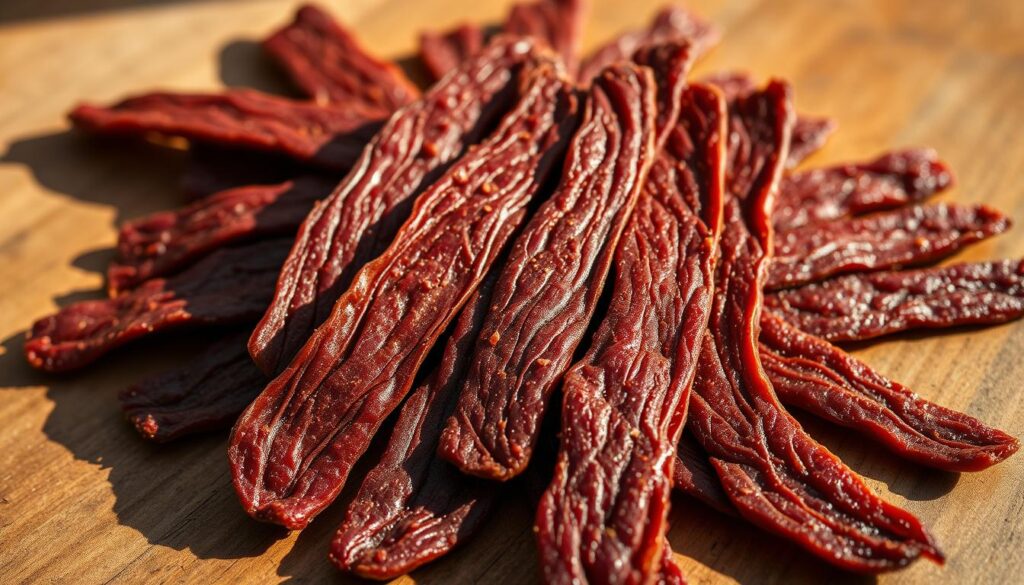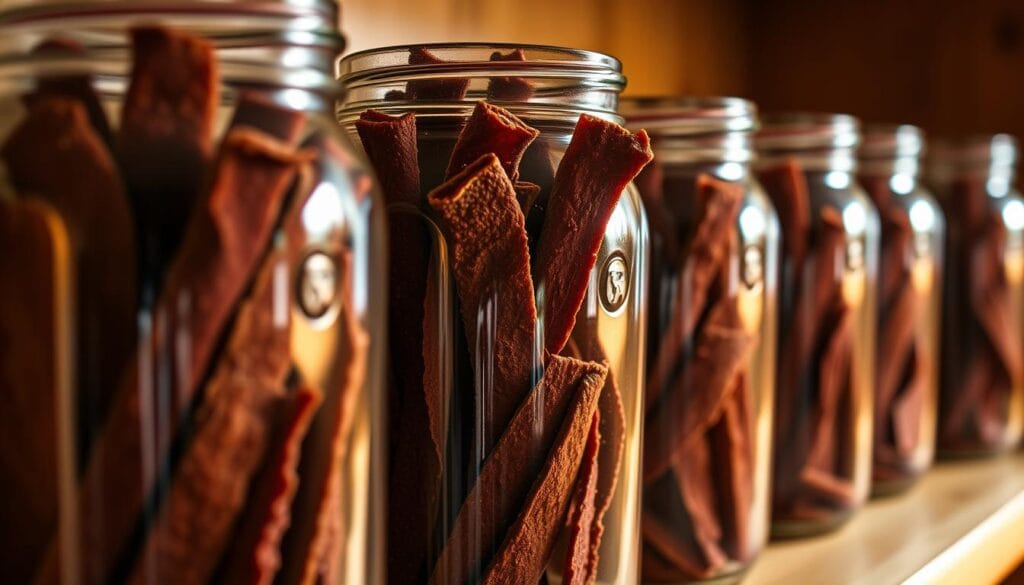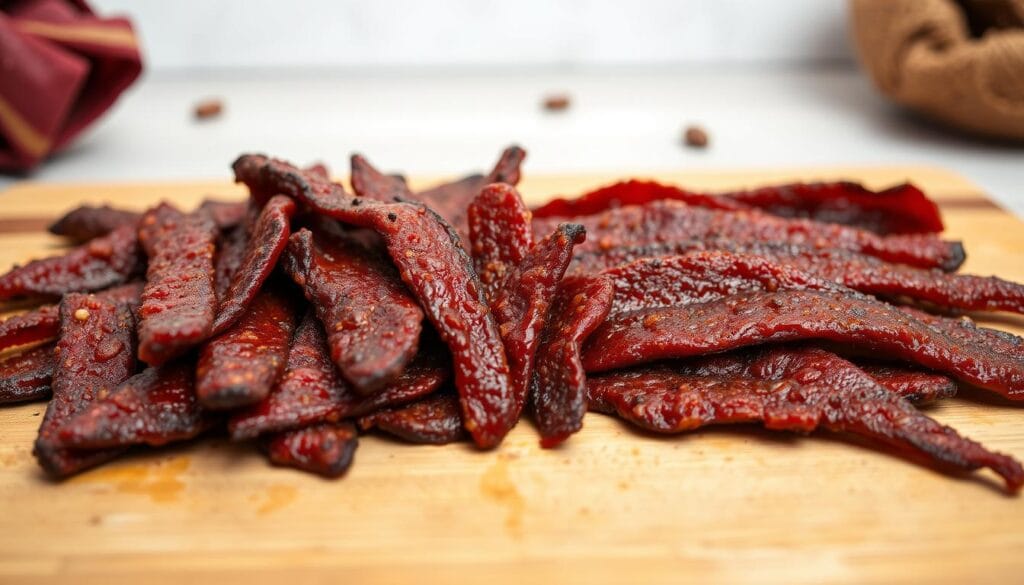Imagine having a healthy snack ready to go, packed with protein and flavor. Making homemade jerky is easier than you think. It’s a great way to control what goes into your food.
You can customize the flavors to your liking, and it’s a fun project to undertake. With a simple ground beef jerky recipe, you can create a delicious and convenient snack.
By making your own jerky at home, you avoid preservatives and additives found in store-bought versions. It’s also a cost-effective way to enjoy your favorite snack.
Table of Contents
Key Takeaways
- Easy to make with simple ingredients
- Customizable flavors to suit your taste
- Avoids preservatives and additives
- Cost-effective snack option
- Packed with protein for a healthy snack
Why Ground Beef Jerky Is a Game-Changer
Making and enjoying ground beef jerky is surprisingly simple and rewarding. You can customize it to your taste. It’s also great for snacking on the go.
Benefits Over Traditional Whole Muscle Jerky
Ground beef jerky is easier to chew than traditional jerky. This makes it perfect for those who find traditional jerky too tough. It’s also simpler to make, requiring less preparation.
You can make a tender and flavorful snack with little effort. Use an easy jerky recipe that fits your taste.
Cost-Effectiveness and Versatility
Ground beef jerky is also more budget-friendly. Using ground beef is cheaper than buying whole cuts of meat for traditional jerky. Plus, it’s very versatile with jerky seasoning.
You can try many flavors, from classic teriyaki to spicy or sweet and savory. This lets you create unique snacks that match your preferences.
| Benefits | Ground Beef Jerky | Traditional Whole Muscle Jerky |
|---|---|---|
| Ease of Chewing | Tender and easy to chew | Can be tough and chewy |
| Preparation Effort | Minimal preparation required | More preparation involved |
| Cost | Budget-friendly | Can be more expensive |
| Flavor Versatility | Highly versatile with various seasonings | Limited to the natural flavor of the meat |
Essential Equipment for Making Homemade Ground Beef Jerky
Starting your homemade jerky journey requires the right tools. To make ground beef jerky, you need a few key items. These ensure your jerky is tender, flavorful, and safe to eat.
Dehydrators vs. Ovens: Pros and Cons
Choosing between a dehydrator and your oven is key for drying jerky. A dehydrator is made for drying foods and has precise temperature control. This is perfect for making jerky. It also helps prevent overcooking.
An oven can also dry jerky, especially if you don’t have a dehydrator. But, you must watch it closely to avoid overcooking. You might need to open the door to lower the temperature. If you make jerky often, a dehydrator is a good buy. For occasional batches, your oven will do.
Must-Have Tools and Accessories
For making ground beef jerky, you’ll need more than just a dehydrator or oven. A jerky gun or piping bag is crucial for making uniform strips. You’ll also need parchment paper or a silicone mat to prevent sticking.
A meat thermometer is vital to ensure your jerky is cooked to a safe temperature.
Optional Equipment for Advanced Jerky Makers
If you want to improve your jerky, consider a vacuum sealer. It keeps your jerky fresh for longer. A meat grinder or food processor is also handy for grinding your own beef.
A marinade injector can add complex flavors by injecting marinades into the meat.
Selecting the Right Ground Beef for Jerky
Choosing the right ground beef is key when making jerky. The quality of your jerky depends on the quality of the meat you use.
Choosing the right ground beef involves understanding two key factors: the lean-to-fat ratio and the overall quality of the meat.
Lean-to-Fat Ratio: Why It Matters
The lean-to-fat ratio is very important for making good jerky. You should aim for a ratio of 96% lean meat or higher. This ensures your jerky is dry and less likely to spoil.
“Excessive fat can lead to jerky that’s not only less healthy but also more susceptible to mold and bacterial growth,” as noted by food safety experts. Using leaner meat helps in achieving that perfect chewy texture that jerky lovers enjoy.
Quality Considerations and Best Cuts
Not all ground beef is the same. The quality of the ground beef you choose can greatly affect the flavor and texture of your jerky. Look for ground beef from reputable sources.
Consider the cut of meat it’s coming from. Cuts like sirloin or round are typically leaner and make better jerky. When shopping, look for ground beef that’s labeled as “grass-fed” or “organic” if those options align with your preferences and budget.
Using a high-quality ground beef not only enhances the taste but also ensures that your jerky is made with the best possible ingredients. As a jerky enthusiast once said,
“The secret to great jerky lies in the quality of the meat you start with.”
The Ultimate Ground Beef Jerky Recipe: Step-by-Step

Creating delicious ground beef jerky at home is easy. You just need a simple recipe and the right tools. First, prepare the meat, mix it with seasonings, and then dry it to perfection.
Ingredients List and Measurements
Here’s what you need for a basic recipe:
- 1 pound lean ground beef (90% lean or leaner)
- 1/4 cup soy sauce (or tamari for gluten-free)
- 1 tablespoon Worcestershire sauce
- 1 tablespoon brown sugar
- 1 teaspoon smoked paprika
- 1 teaspoon garlic powder
- 1/2 teaspoon onion powder
- 1/2 teaspoon salt
- 1/4 teaspoon black pepper
- 1/4 teaspoon cayenne pepper (optional for some heat)
You can change the seasonings to suit your taste. Add eriander for a unique flavor or more cayenne for spice.
Mixing and Seasoning the Meat
In a large bowl, mix the ground beef with the marinade. Use your hands or a spoon to coat the meat evenly. Don’t overmix to avoid tough jerky.
Tip: Marinating the meat longer can make the flavors better. Refrigerate it for a few hours or overnight if you can.
Forming the Jerky
To shape the jerky, you can hand-form it or use a jerky gun. If hand-forming, lay the mixture on parchment paper or a jerky mat. Flatten it to the right thickness. For uniform jerky, use a jerky gun or a meat grinder with a jerky attachment.
Pre-Cooking Safety Measures
Before dehydrating, make sure your jerky is safe to eat. Always handle raw meat safely. Wash your hands well after handling raw ground beef. Also, ensure your jerky reaches a safe internal temperature during drying.
Determining When Your Jerky Is Done
The jerky is ready when it’s dry and slightly flexible. It should not be too dry. The internal temperature should be at least 160°F (71°C) for safety. Let it cool completely before storing in airtight containers.
Dehydrating Methods for Ground Beef Jerky
To get the perfect jerky, knowing how to dehydrate is key. There are several ways to dry ground beef jerky, each with its own benefits.
Using a Food Dehydrator
A food dehydrator is made to remove moisture from food well. It creates a controlled space for drying jerky evenly. Just put the jerky strips on the trays, leaving space for air, and set the temperature to 135°F to 155°F.
Dehydrators offer precise temperature control and even drying. This helps keep the jerky’s texture and flavor. Many dehydrators have settings for making jerky, making it easier.
Oven-Drying Techniques
If you don’t have a dehydrator, your oven can work too. Preheat it to its lowest setting, around 150°F to 200°F. Put the jerky strips on a baking sheet lined with parchment paper, without overlapping.
Keep the oven door a bit open to let moisture out. This helps dry the jerky evenly and prevents it from steaming. Adjust the drying time based on your oven’s temperature and the jerky’s thickness.
Determining When Your Jerky Is Done
It’s important to know when your jerky is ready, no matter the method. It should be dry and slightly flexible, not brittle or wet. Check by taking a piece out and letting it cool to room temperature.
| Dehydrating Method | Temperature | Drying Time | Texture |
|---|---|---|---|
| Food Dehydrator | 135°F – 155°F | 4-6 hours | Dry, flexible |
| Oven Drying | 150°F – 200°F | 3-5 hours | Dry, slightly flexible |
By using these dehydrating methods, you can make delicious ground beef jerky. Whether you use a dehydrator or your oven, aim for the right dryness and flexibility.
Flavor Variations and Marinades
Ground beef jerky is great because it can take on many flavors. It’s perfect for those who love trying new seasonings and marinades. You can make it classic and savory or spicy and adventurous, depending on your taste.
Classic Teriyaki Jerky Recipe
Teriyaki jerky is a favorite for many. It’s made by marinating ground beef in soy sauce, brown sugar, garlic, and ginger. This mix makes the jerky sweet and savory, perfect for snacking.
To make it, mix ground beef with 1/4 cup soy sauce, 2 tablespoons brown sugar, 2 cloves garlic, and 1 tablespoon ginger. Then, dehydrate it as usual.
Spicy Ground Beef Jerky Options
If you like spicy food, add diced jalapeños or serrano peppers to your jerky. You can also use hot sauce or red pepper flakes for more heat. Try adding sriracha to your teriyaki marinade for a spicy twist.
Sweet and Savory Combinations
Mixing sweet and savory flavors creates unique jerky. Try honey with smoked paprika and a bit of cumin for a sweet and smoky taste. Or, use brown sugar and cracked black pepper for a simple yet tasty flavor.
International Flavor Profiles
Adding international flavors can make your jerky exciting. For example, Korean-inspired jerky uses gochujang, soy sauce, brown sugar, and sesame oil. Mexican-style jerky can be made with chili powder, lime juice, and cilantro. Exploring global flavors is a fun culinary journey.
Food Safety and Proper Handling
Homemade jerky needs careful handling to avoid foodborne illnesses. It’s key to handle and store the meat right for safe eating.
Critical Temperature Guidelines
To make sure your homemade jerky is safe, follow critical temperature guidelines. The jerky’s internal temperature should hit at least 160°F (71°C) to kill off bacteria. Use a food thermometer to check the temperature, especially when using a dehydrator or oven.
- Preheat your dehydrator or oven to the recommended temperature.
- Ensure the jerky is dried to an internal temperature of 160°F (71°C).
- Check the temperature in multiple pieces to ensure consistency.
Curing Salts and Their Purpose
Curing salts are key in making homemade jerky safe. They contain sodium nitrite, which helps prevent bacterial growth and adds flavor. Always follow the manufacturer’s instructions for the right amount to use.
Remember, curing salts help with safety but don’t replace proper handling and temperature control.
USDA Recommendations for Homemade Jerky
The USDA has guidelines for safe homemade jerky. They say to heat the meat to 160°F (71°C) before dehydrating. They also suggest using a dehydrator that keeps a temperature of 130°F to 140°F (54°C to 60°C).
By sticking to these guidelines and using proper handling, you can enjoy your homemade jerky safely.
Storing and Preserving Your Homemade Jerky

To keep your homemade ground beef jerky fresh, follow some key steps. Proper storage keeps the taste and texture great. It also makes sure your jerky stays safe to eat.
Proper Packaging Methods
Choosing the right packaging is crucial. Use airtight containers or zip-top bags to block air, moisture, and germs. For longer storage, vacuum-sealing is best to stop oxidation and spoilage. Always use clean, dry utensils when handling jerky to avoid contamination.
- Use airtight containers or zip-top bags.
- Consider vacuum-sealing for long-term storage.
- Handle jerky with clean, dry utensils.
Shelf Life Expectations
The shelf life of your homemade jerky depends on storage. Properly stored in airtight containers, it can last weeks to months. Check on your jerky periodically for signs of spoilage, like bad smells or mold.
For longer storage, keep these tips in mind:
- Store it in a cool, dry place.
- Keep it away from direct sunlight.
- Check on it regularly.
Refrigeration vs. Room Temperature Storage
You can store your homemade jerky at room temperature or in the fridge. Room temperature is good for short storage, while the fridge is better for longer. Refrigeration can significantly extend the shelf life of your jerky.
By following these tips, you can enjoy your homemade ground beef jerky for a longer time. This way, you keep its quality and safety.
Conclusion: Enjoying Your Homemade Ground Beef Jerky
Now that you know how to make ground beef jerky at home, it’s time to enjoy it. You can make this tasty snack whenever you want. Try different flavors and marinades to keep it exciting.
Homemade jerky is great on its own or with your favorite drinks. Make sure to store it right to keep it fresh. It’s perfect for a quick snack or to fuel your adventures.
Don’t be afraid to try new things with your jerky recipe. You can use different seasonings and ingredients to find your favorite flavor. The joy of making and eating your own jerky is unmatched.

